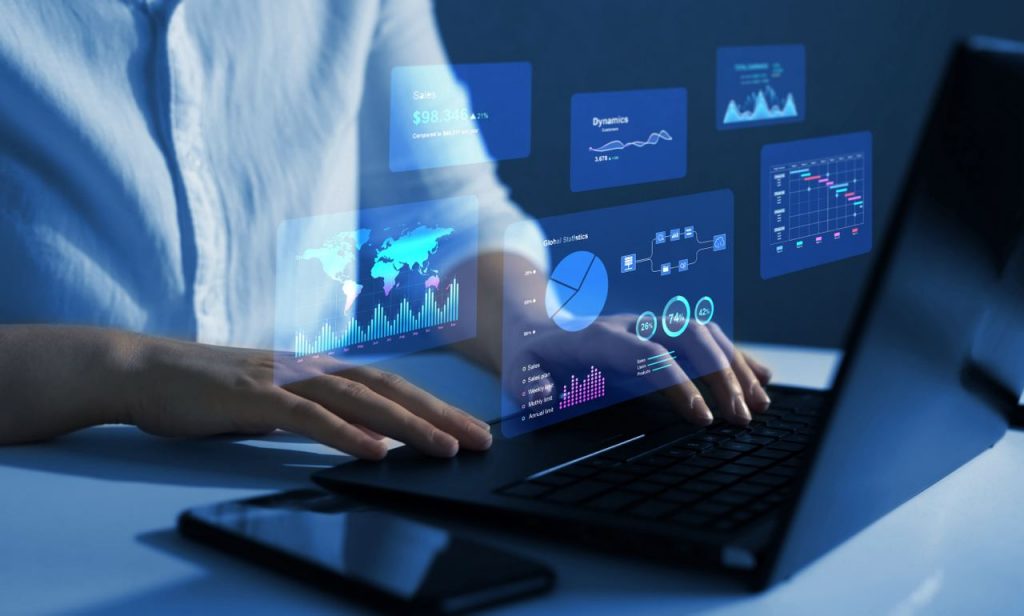In the 21st century, we find ourselves immersed in a technology-driven world that has transformed nearly every aspect of our lives. From the way we communicate to how we work and learn, technology has reshaped our reality. The rapid evolution of digital tools and platforms has opened up unprecedented opportunities for innovation, collaboration, and personal growth. However, this technological revolution is not without its challenges. Issues such as job displacement, cybersecurity threats, and social isolation are emerging as significant concerns in our increasingly connected society. This article explores the profound impact of technology, examining both the opportunities it presents and the challenges it poses, ultimately aiming to provide a nuanced understanding of this complex relationship.
Navigating a Technology-Driven World: Opportunities and Challenges

Technology has undeniably revolutionized the way we live, work, and interact with one another. As we navigate this technology-driven landscape, it is essential to recognize the myriad opportunities that arise from these advancements while also addressing the challenges they present.
Improved Communication and Connectivity
The advent of the internet and mobile devices has fundamentally altered the way we communicate. Geographical boundaries that once limited interaction have been shattered, allowing for near-instantaneous communication across vast distances. This newfound connectivity fosters global collaboration, enabling individuals and organizations to work together regardless of their physical location.
Moreover, social media platforms have amplified these abilities, providing individuals and communities with the tools to connect, engage in discourse, and mobilize for social causes. The ability to share experiences and information in real-time has empowered people to advocate for change and raise awareness on critical issues. For instance, movements like
MeToo and Black Lives Matter have gained momentum through social media, demonstrating the power of technology in facilitating social justice initiatives.
However, while improved communication has its benefits, it can also lead to superficial interactions and a decline in face-to-face relationships. As we become more reliant on digital communication, we must be mindful of maintaining genuine connections with others and fostering meaningful relationships.
Enhanced Efficiency and Automation
One of the most significant advantages of technology lies in its ability to enhance efficiency and productivity across various sectors. Automation, powered by robots and intelligent algorithms, has streamlined complex processes, freeing up human resources for more creative and strategic tasks. In manufacturing, automated production lines have significantly increased output and reduced costs, leading to higher profitability for businesses.
In healthcare, technology has enabled more accurate diagnoses, personalized treatments, and remote consultations, improving patient care. Telemedicine, for example, allows patients to receive medical advice from specialists without the need for travel, making healthcare more accessible to those in underserved areas. Additionally, advancements in data analytics have empowered healthcare providers to make informed decisions based on real-time patient data, ultimately leading to better health outcomes.
Despite these advancements, the rise of automation raises concerns about job displacement. As machines take over routine tasks, workers in certain industries may find themselves at risk of unemployment. It is crucial for policymakers and business leaders to address these challenges by investing in workforce development and retraining programs to ensure that individuals can adapt to the changing job landscape.
Democratization of Knowledge and Access to Information
The internet has become a vast repository of knowledge, democratizing access to information like never before. Individuals from all walks of life can tap into online educational platforms, bridging geographical gaps and providing opportunities for learning new skills or pursuing higher education. This democratization of knowledge fosters social mobility, empowering individuals to make informed decisions and pursue their aspirations.
Online courses, webinars, and open-access resources have made it possible for anyone with an internet connection to gain knowledge in various fields, from coding to art history. This accessibility has the potential to level the playing field, allowing individuals in developing countries to access quality education and training that was previously out of reach.
However, the abundance of information available online also presents challenges. The sheer volume of content can lead to information overload, making it difficult for individuals to discern credible sources from unreliable ones. Furthermore, disparities in digital literacy can exacerbate existing inequalities, as those with limited skills may struggle to navigate the wealth of information available to them.
Advancements in Healthcare and Life Sciences
Technological innovations have catalyzed a revolution in medicine and biotechnology, offering new hope for tackling previously incurable diseases. Innovative diagnostic tools, personalized therapies, and advancements in genomics are transforming the healthcare landscape. For instance, precision medicine tailors treatment plans based on an individual’s genetic makeup, leading to more effective interventions and improved patient outcomes.
Telemedicine has emerged as a game-changer, particularly in light of the COVID-19 pandemic. Remote healthcare services have become essential for maintaining access to medical expertise, especially in underserved areas where healthcare facilities may be scarce. Patients can now consult with doctors via video calls, receive prescriptions electronically, and monitor their health using wearable devices.
Despite these advancements, ethical considerations surrounding healthcare technology must be addressed. Issues related to data privacy, consent, and equitable access to cutting-edge treatments require careful examination to ensure that technological progress benefits all individuals, regardless of their socioeconomic status.
Sustainability and Environmental Solutions
As the world grapples with pressing environmental challenges, technology has the potential to play a crucial role in promoting sustainability. Renewable energy technologies, such as solar and wind power, offer sustainable alternatives to fossil fuels, reducing greenhouse gas emissions and mitigating climate change. Innovations in energy storage and smart grids further enhance the efficiency of renewable energy systems, enabling a transition toward a more sustainable energy future.
In agriculture, technology is transforming traditional practices through precision farming and environmental monitoring systems. Farmers can utilize data analytics and IoT devices to optimize resource utilization, minimize waste, and improve crop yields. These advancements contribute to food security while minimizing the environmental impact of agricultural practices.
However, the adoption of sustainable technologies requires investment and commitment from governments, businesses, and individuals. Transitioning to a greener economy necessitates collaboration and innovative policies that incentivize sustainable practices and support research and development in clean technologies.
Digital Divide and Social Inequality
While technology offers immense opportunities, it also presents challenges related to the digital divide and social inequality. The digital revolution has not been uniformly distributed across the globe, with access to technology remaining limited in many developing countries. Factors such as poverty, infrastructure gaps, and limited digital literacy contribute to this disparity, hindering opportunities for individuals in underserved communities to benefit from the transformative potential of technology.
The digital divide exacerbates existing social and economic inequalities, creating a cycle of disadvantage for those without access to technology. Individuals in low-income areas may lack reliable internet connectivity, limiting their ability to participate in online education, job training, and remote work opportunities. Bridging this gap requires targeted efforts to improve infrastructure, provide affordable internet access, and enhance digital literacy programs.
Furthermore, addressing the digital divide involves recognizing the intersectionality of technology and social issues. Marginalized communities, including racial and ethnic minorities, often face additional barriers to accessing technology. Ensuring that all individuals have equal opportunities to thrive in a technology-driven world is essential for fostering inclusivity and social equity.
Job Displacement and Economic Disruption
The rise of automation and artificial intelligence is transforming the labor market, leading to the displacement of certain jobs. While new opportunities are being created in fields related to technology, the transition can be challenging for individuals whose skills are no longer in demand. This economic disruption requires adaptive policies to retrain workers and prepare them for the evolving job market.
As industries embrace automation to enhance efficiency, workers in roles that involve repetitive tasks may find themselves at risk of redundancy. For instance, manufacturing jobs that once relied heavily on manual labor are increasingly being replaced by robotic systems. To mitigate the impact of job displacement, governments and educational institutions must implement programs that focus on reskilling and upskilling workers, equipping them with the skills needed for emerging industries.
Additionally, fostering a culture of lifelong learning is essential in a rapidly changing job landscape. Individuals should be encouraged to continuously update their skills and adapt to new technologies, ensuring that they remain competitive in the workforce. Collaboration between businesses, educational institutions, and government agencies will be crucial in creating pathways for workforce development and economic resilience.
Cybersecurity Threats and Data Privacy Concerns
The proliferation of connected devices and reliance on digital infrastructure increase vulnerabilities to cyberattacks. Malware, phishing scams, and data breaches pose significant threats to individuals, businesses, and governments alike. As technology becomes more integrated into our daily lives, the importance of cybersecurity cannot be overstated.
Data privacy concerns also arise as technology companies collect vast amounts of personal information. The ethical implications of data usage, surveillance, and potential misuse of information raise questions about individual rights and privacy. Striking a balance between technological advancement and safeguarding personal data is essential for building trust in digital systems.
To combat cybersecurity threats, a multi-pronged approach is necessary. Governments, businesses, and individuals must collaborate to strengthen cybersecurity protocols and promote responsible data handling practices. Regulations should be implemented to enforce robust security measures, while individuals should be educated about cybersecurity risks and encouraged to adopt safe online practices.
Social Isolation and Disconnect
While technology facilitates communication and connection, there is a growing concern about its potential to foster social isolation and disconnect. Excessive screen time can detract from face-to-face interaction, impacting social skills and emotional well-being, particularly among younger generations. The rise of social media has created a paradox where individuals may feel more connected online yet experience feelings of loneliness and disconnection in their offline lives.
To address these challenges, it is essential to encourage mindful technology usage and promote healthy digital habits. Establishing boundaries around screen time, prioritizing face-to-face interactions, and engaging in activities that foster offline connection are crucial steps toward balancing technology with human connection. Communities can play a vital role in creating spaces for social engagement, encouraging individuals to come together and build meaningful relationships beyond the digital realm.
The Rise of Fake News and Misinformation
The internet, while a powerful tool for information dissemination, is also susceptible to the spread of fake news and misinformation. The rapid propagation of false or misleading content through social media algorithms can have devastating consequences, influencing public opinion, fueling social unrest, and undermining trust in reliable sources of information.
Combatting the spread of misinformation requires a concerted effort to promote media literacy and critical thinking skills. Individuals must be equipped to discern reliable information sources from biased or misleading content. Educational initiatives that focus on teaching media literacy can empower individuals to navigate the digital landscape more effectively.
Social media platforms also bear responsibility for addressing the issue of misinformation. Implementing stricter verification processes for news sources and developing mechanisms to flag and remove false information are essential steps toward fostering a more informed public discourse. Collaboration between technology companies, journalists, and educators can help create a more resilient information ecosystem.
Technology’s impact on the world is undeniable, presenting both unprecedented opportunities and evolving challenges. Navigating this complex landscape requires a proactive and collaborative approach. By embracing innovation while addressing its potential pitfalls, we can harness technology’s transformative power to create a more equitable, sustainable, and prosperous future for all.
Recognizing the importance of digital literacy, preparing workforces for the future, ensuring cybersecurity, balancing technology with human connection, and combating misinformation are essential steps in navigating the technology-driven world. The key lies in fostering a global dialogue that balances progress with ethical considerations, ensuring that technology serves humanity and not the other way around. As we move forward, it is imperative that we remain vigilant in addressing the challenges posed by technology while fully embracing its potential to enhance our lives and shape a better future.
